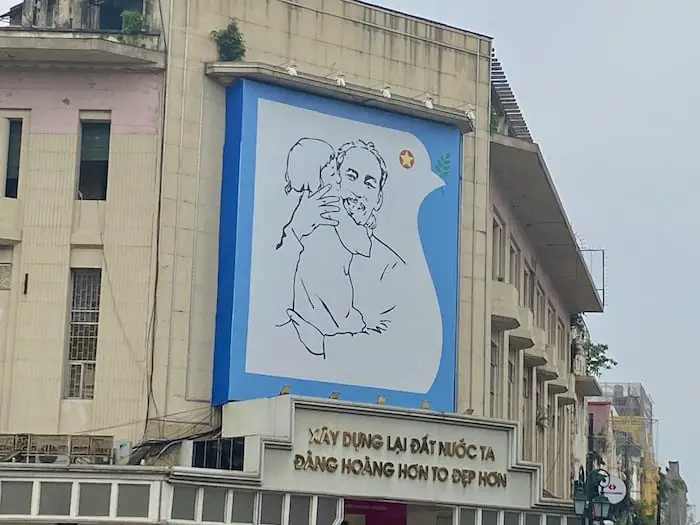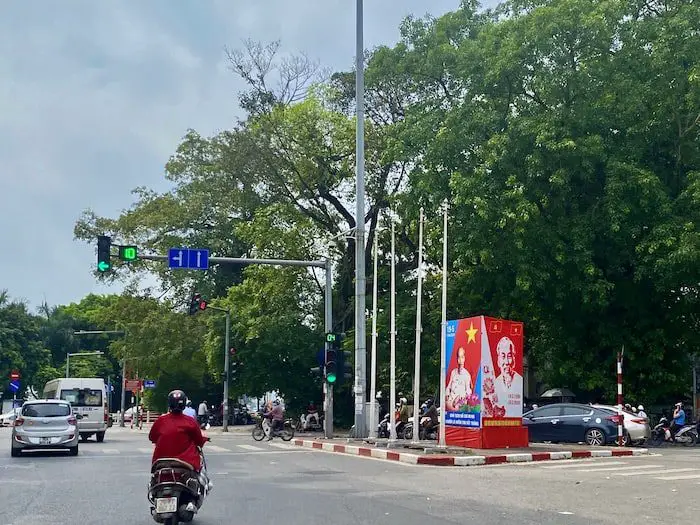As you travel around Vietnam, you will see these large posters on the intersections and street corners which depict some kind of theme about life in Vietnam. These posters are known as a propaganda art posters.
Propaganda posters first started in the Soviet Union and then spread to other socialist countries like Vietnam. For many years, posters have been an essential part of the Vietnamese art scene. You can still see the propaganda art posters around Vietnam.
Table of Contents
- The Start Of The Propaganda Posters
- Propaganda Posters in Vietnam
- Propaganda Art In Vietnam Today
- About Vietnamese Propaganda Art
- Where to Purchase Vietnamese Propaganda Art
- Related Questions

The Start Of The Propaganda Posters
In the former Soviet Union, the Marxist-Leninist ideology used propaganda art posters. These posters first appeared in the early 1990s. ,
The propaganda art posters were used to depict and show the Red Army’s many triumphs in the Soviet Union. The designs and colors were chosen to be bold with simple designs so that even the illiterate could understand the meaning of the posters.
Vladimir Lenin, the Russian revolutionary, politician, and political theorist said this about using art:
“The art of any propagandist and agitator consists in his ability to find the best means of influencing any given audience by presenting a definite truth, in such a way as to make it most convincing, most easy to digest, most graphic, and most strongly impressive.”
Vladimir Lenin

Propaganda Posters in Vietnam
Many believe that propaganda art posters started in Vietnam during the Vietnam War (1955-1975). But propaganda posters were known to exist in the 1940s when the French still ruled Vietnam. The propaganda art posters would have been used by Ho Chi Minh and the Viet Cong to promote their cause and not by the French Government.
Ho Chi Minh or Uncle Ho as he is lovingly called by the Vietnamese, understood the power of art in educating and telling a story. After the French left Vietnam in 1954, the dominant art style of Vietnam was propaganda art that followed the Leninist approach to art. The Leninists thought believed that:
“..art is not art unless it is propaganda.”
Leninist thought
Ho Chi Minh and the famous Vietnamese General Vo Nguyen Giap understood the power of art to communicate their ideas. They used art and in particular, propaganda art posters to convey their message to the Vietnamese people. This is how the very simple, yet brightly colored art became such an essential part of Vietnamese culture and life.
Propaganda Art During the Vietnam War Years (1955-1975)
As the war in Vietnam raged for twenty years between 1955 to 1975, the propaganda posters became an essential nationwide rallying call to arms. The posters helped boost a sense of nationalism and Vietnamese pride.
Many propaganda artists would trek through the dense Vietnamese jungles with their comrades-in-arms, essentially hardened front-line soldiers. These same artists were not soldiers but students or volunteers, yet they lived under the constant threat of American bombers, being captured or killed. This was not an ideal environment for any artist.
Yet despite this hardship, the propaganda artists continued to produce a huge amount of important propaganda artwork. For these artists, it was a way to defy the enemy and show their nationalist pride and determination. That is why in their art during this time frame is a sense of optimism, peace, and hope for their country.
Propaganda Art In Vietnam Today
Today as you travel to Vietnam, you will see propaganda art all over Vietnam. The propaganda art is on large-size posters on major intersections, street corners, or traffic circles. In some of the Vietnamese countryside areas, you may see huge billboard-size propaganda posters.
I have lived and worked in Vietnam for many years. I have to admit until I decided to write this blog about propaganda art posters, I passed by these posters frequently but did not pay much attention to them. They are very much a part of Vietnamese culture and life, so if they disappeared, I would miss seeing them.

About Vietnamese Propaganda Art
Vietnamese propaganda art is as varied as the artists that produced it. In the war years, many students and volunteers were involved in the production of the art. Because of this, the art in this period is as varied as the artists who produced it.
Here is some general information about Vietnamese propaganda art:
- School of Fine Arts, Hanoi – Many propaganda artists attended the School of Fine Arts in Hanoi. This is still one best art schools in Vietnam.
- Artists – In the early years of propaganda art, many different kinds of artists, students, and volunteers were involved in producing propaganda posters. Today propaganda posters are produced by propaganda artists that work for the Vietnamese government. This is why today, the style of propaganda art is quite similar and uniform.
- Vietnamese Style – During the war years, The School of Fine Arts selected some students to go to the Soviet Union to study the Russian propaganda art style. In some of the art pieces in this era you can see the influence of Russian propaganda art, but most of the Vietnamese propaganda art has a decidedly Vietnamese style.
- Bright and Colorful – The artwork of Vietnamese propaganda art uses bright and bold colors. Even today, you see a lot of art using the colors of the Vietnamese flag, with red and yellow being the predominant colors of choice for the artists.
- Empathy Through Realism – One of the main objectives of Vietnamese propaganda art is to help the viewers to have empathy through realism. You can see this in the propaganda art today as you see ordinary people next to Ho Chi Minh with everyday objects like fish, books, flowers, or vases. Other everyday people, as a workers with hard hats, show the importance of everyday laborers to Vietnamese life.
- Artistic Style – The artistic style of the propaganda posters is simple and has an art graphic feel. Bold colors cover large spaces of the artwork. Specific symbols will be used, such as the lotus flower, a star, the Vietnamese flag, or the Communist sickle.
Themes of Vietnamese Proganada Artwork Explained
There are a few common themes that run through Vietnamese propaganda artwork. The common themes are:
- Ho Chi Minh – One of the major themes of the propaganda artwork in Ho Chi Minh. Ho Chi Minh is highly revered and considered the founder of the Republic of Vietnam.
- Women – The role of women is significant in Vietnamese society. So many of the posters will emphasize the role and importance of women. Many women were heavily involved in the war effort, so during the war era, the artists acknowledged the importance of women through posters.
- Children – You will see many posters that may have Ho Chi Minh surrounded or holding children. The children can symbolize many things, but among them is the future of Vietnam.
- Workers – Many posters will show all kinds of workers in Vietnam doing various jobs. Workers from the military to construction workers. This can symbolize the importance of everyone in Vietnamese society working together for the nation’s good.
Where to Purchase Vietnamese Propaganda Art
Hanoi, Vietnam, is renowned for its excellent selection of Vietnamese propaganda art. However, the COVID pandemic and the subsequent decline in tourism led to the closure of many such shops.
For those interested, you can visit the Vietnam Old Propaganda Posters store, located at 43A Hàng Bè, Hanoi, Vietnam, to explore their collection. You can find out more on their facebook page by clicking here.
The Vietnamese Propaganda Shop has reprints on rice paper, and they have a website where you can purchase online and they will send it to you anywhere in the world.
Vietnamese propaganda art posters are wonderful works of art. These amazing works of art tell a lot about Vietnam’s history, people, and culture.
At A Bus On A Dusty Road, we talk about travel, life, and ex-pat living. We are all about “Living Life As A Global Citizen.” We explore social, cultural, and economic issues and travel.
We would love to have you be part of our community. Sign up for our newsletter to keep up-to-date by clicking here. If you have any questions, you can contact me, Anita, by clicking here.
Listen to our Podcast called Dusty Roads. You can find it on all major podcast platforms. Try out listening to one of our podcasts by clicking here.
Subscribe to our A Bus On A Dusty Road YouTube Channel filled with great videos and information by clicking here.
Related Questions
What Are the Vietnamese Bamboo Instruments?
Bamboo is a plant that grows throughout Asia. Because bamboo is so abundant, many Asian cultures have bamboo instruments as part of their traditional music. Vietnam uses a lot of bamboo musical instruments for its traditional music. Vietnam’s ethnic hill tribe minorities use bamboo musical instruments in their music.
You can learn more about Vietnamese bamboo musical instruments by reading our blog Vietnamese Bamboo Musical Instruments, What You Need to Know by clicking here.
Who Built the Long Bien Bridge?
The Long Bien Bridge is in Hanoi, Vietnam. It is an iconic bridge designed by the great architect Gustave Eiffel. The bridge has a long history and is an integral part of the history of French rule throughout Vietnam. The Long Bien Bridge was a target of bombings by the American forces during the Vietnam War. Today you can ride a motorcycle, or bicycle or walk across the Long Bien bridge.
You can read more about the Long Bien bridge by reading our blog Who Built the Long Bien Bridge in Hanoi, Vietnam? by clicking here.

